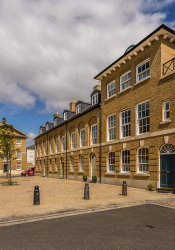Poundbury, England
Poundbury was an attempt by Charles, Prince of Wales to build an ideal, high-density urban environment that was designed to reduce car dependency and encourage walking, cycling, and public transportation. Parking for cars is mainly located behind homes to allow for spacious streetscapes that are free from clutter. Homes are built close to eachother to foster community. The ideas for Poundbury's design are founded on sustainability. One element that achieves this is the anaerobic digester on the edge of town, which can break down biodegradable material and transform the resulting biogas into electricity and heat. Plans for Poundbury's creation were revealed in 1987. While originally scheduled for completion in 2015, it is still under construction. Currently, the population is around 3,000. The design of the town appeals to many looking for a peaceful place to live, however some critics have called it a "cottagey slum", as well as a folksy pastiche with a hint of Arts and Crafts. Despite this, it has been an economic success, estimated to contribute a further €500 million to the local economy by 2025. Overall, Poundbury’s planning is a radically innovative change to the planning assumptions of the 20th century.
Sources:
Norwood, Graham. “Poundbury: A look at Prince Charles' sustainable village in Dorset.” The Telegraph, Telegraph Media Group, 26 Apr. 2017, https://www.telegraph.co.uk/property/buy/poundbury-look-prince-charles-s....
“Poundbury .” Duchy of Cornwall, duchyofcornwall.org/poundbury.html.
“Poundbury.” Wikipedia, Wikimedia Foundation, 8 Mar. 2018, en.wikipedia.org/wiki/Poundbury.
Image Source: http://www.johnsimpsonarchitects.com/pa/Poundbury.html

